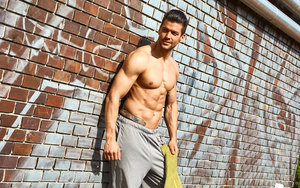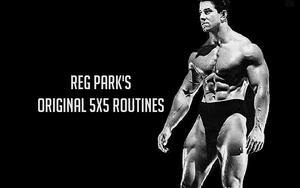
Complete Beginner's Guide To Gaining Muscle
Never having set foot in a gym, not knowing where to start and perhaps being a tad self-conscious about it all can be a big factor for many people not getting on with it.
Having some foreknowledge of the basics of resistance training, a simple workout plan, realistic expectations and the proper mindset is all you need to turn your first workout into a lifelong habit. We will cover all of these and more below!
Table of Contents
- You Need Strength Training!
- A Starting Point: Building the Base
- Routine Progressions: Beginner Strength Training Routines
- In Closing
You Need Strength Training!
Strength training can take on many forms: free weights, resistance machines, and even bodyweight exercises to work the skeletal muscles under load which is typically progressive in nature, to increase muscular size, strength and endurance.
The benefits of strength training are far beyond just aesthetics. They include:
- Increased muscle mass and body composition
- Building bone density and lowers the risk of osteoporosis
- Joint flexibility & stability
- Improve cardiovascular risk factors
- Lower high blood pressure
- Optimising body mass index
- Improved basal metabolism/fat burning
- Lowers the risk of diabetes and metabolic syndrome
- Boost energy levels and mood/mental health
- Increased self-confidence
- Decreased risk of falls
- Slow down ageing and age-related muscle loss ("sarcopenia")
- Boost brain health
- Possibly improve the management of certain disease processes such as MS and Parkinson's
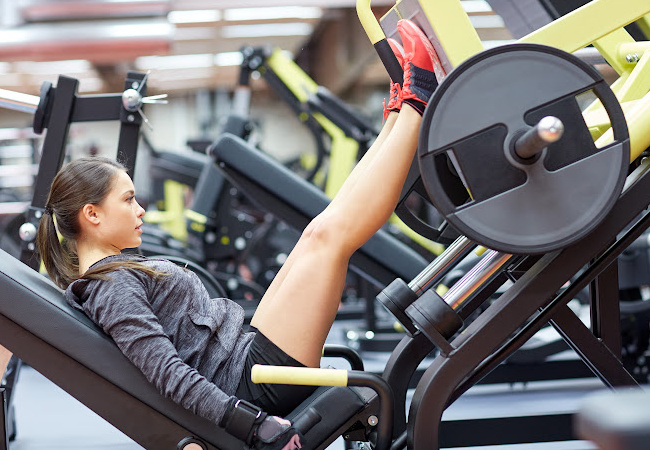
Establishing Mindset
Feeling confident about one's ability to accomplish any goal invariably starts with defining our purpose, changing our self-perception, coupled with positive action towards our goals while being consistent with our efforts.
There are many tactics to cultivate an altered, positive mindset, such as writing a few of your goals on index cards to mentally reinforce and condition your new values, things like visualization of your workouts and progress.
Another thing that can help get you in the mood, or even ground yourself is music. We all have our favorite music that gets us in the right frame of mind and energizes us.
Begin to think of yourself now as an athletic version of your former self and your training being a necessary and vital part of your life now and so on. Your time in the gym your time, shut everything else out of your mind for the time you are there.
Setting Realistic Expectations
What are your goals? Are they to just lose 10-20 pounds and gain some muscle, weight loss, muscle toning, getting stronger or any of the benefits in the list above?
Being realistic with yourself is vital so you don't set yourself up for overdoing it, over-extending your self and setting yourself up for failure.
This is exactly why a sound program which covers the fundamentals while keeping it all simple is the best base for success with realistic goals, such as gaining 8-15 pounds of muscle in the first 2-3 months or losing 3 pounds a week, both with proper training and diet are quite reasonable.
Most people are, believe it or not, just like your and I and actually have realistic and modest goals, preferring natural strength training and are not interested in setting powerlifting records or entering bodybuilding competitions.
The take-home point being that your goals and aspirations will likely be what most of the people you see in any gym also have.
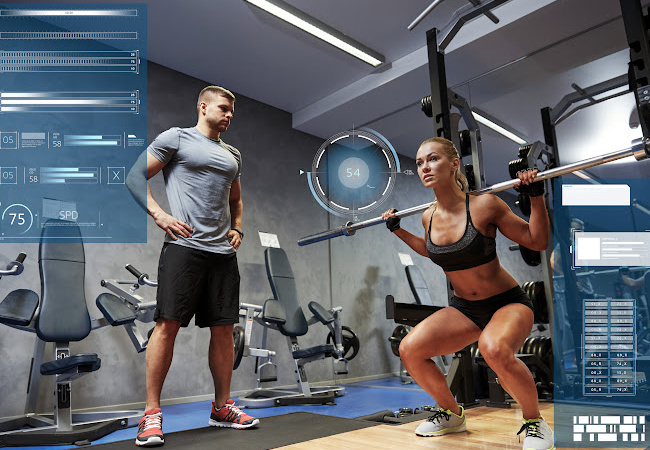
Exercise as Habit
What we are actually looking at setting our to do are the beginning steps, however small, of making regular physical exercise a lifelong habit. The slow and stead, over time, will see you win the race.
The biggest tool in your arsenal, besides a positive "get it done" mindset, is the power of consistency. Below we will get into how and why we start of with simple workout routines which give you maximal benefit and do not over complicate things, which will make it more likely that you will enthusiastically stick to training without getting overwhelmed.
Tactically, the best approach to forming positive habits is by starting off small. One book which many of you have no doubt heard of that provides a proven framework for improving any area of your life with positive habituation is the book "Atomic Habits" by author James Clear.
Doing something towards a desired positive action outcome is always better than doing nothing!
Simplicity Gives You the Edge
As I alluded to above, simple routines which give us the biggest bang-for-buck in terms of effort and time are our best bet - particularly for beginners!
We've all heard of this business of the "80/20" rule, that a mere 20% of your efforts give you roughly 80% of the benefits.
Keeping our focus on what's most important, such as exercises which target large muscle groups, compounds movements, full body routines, avoiding failure and burnout and even wasted time and money by not buying into any of the endless dogma out there, scams and magical celebrity routines.

What Routine is Best For Me?
You will find that it will take some time experimenting with finding out what sort of training routines and tools you prefer. Do you feel more comfortable with barbell, dumbbells, machines or cables? Or do you like to mix it up?
Sets, Reps, Volume
Simply put, a "set" is a string of a consecutive number of repetitions. This can be a pre-planned number of reps or done until at or close to the point of momentary muscle failure. Therefore 3 sets of 10 means three sets of 10 consecutive repetitions for each set.
Each repetition is comprised of two types of isotonic contractions, an concentric and eccentric one. The concentric is the shortening of the muscle under load, the eccentric is its lengthening. For example, in a biceps curl, the upward contraction where the weight is raised and the muscle shortens, is the concentric and the lowering of the weight is the eccentric.
Research has demonstrated that the eccentric portion of an exercise is responsible for building more muscle mass.
When volume is mentioned it is a measure of the overall number of sets done for each bodypart. This can range between 2 to 20 sets done per week, per bodypart.
A good starting point for most people would be doing a minimum of 5 sets per week, in the range of 50% to 70% one-repetition maximum, each set taken within 1-2 reps short of momentary muscle failure. Optimally, we want to get to the point of subjecting the major muscle groups in the body to 8-12 sets per week.
Note, the "one-repetition maximum" or "1RM" is something which you can safely calculate using any one of a number of online 1RM calculators, without risking injury by actually attempting a max lift (something beginners should not even think of doing at this stage of the game)
Frequency, Duration and Time: How Long Should I Train For?
This is where some individual subjectivity comes in again:
How old are you or do you have injuries?
How many days can you/want to train per week?
How much time do you have for each workout?
What is your recovery ability like?
Given how the above questions illustrate there is no one conclusive answer as to the optimal number of workouts, and that this is entirely dependent on the individual, it is safe to say that anywhere from 1-4 training sessions per week should cover the best results for the majority of the population.
Each workout session can last anywhere from 20-45 minutes, assuming that there is enough intensity within proper form, using typically with 1-3 minutes between each set.
How long each set should take is another important point to bring up. You might have heard of the term "time under tension". This is the measure of how long the muscle is forced to contract, under load, over a given number of repetitions. The total time is said to be the time under load. This metric is one of the most common ways to gauge intensity (besides perceived intensity).
The cadence of the repetitions varies, but the best results are seen with controlled lowering of the weights in the eccentric portion of the lifts. It doesn't have to be super slow, but optimally 3-4 seconds down and 2 seconds up is a reasonable starting point. It also helps guide us to using loads which are not too heavy.

Tracking Progress
It is imperative that you keep some sort of training log or even a more comprehensive journal of not just the workout done, but also how you were feeling on a given day, the surfacing of any injury or pain, recovery etc.
At a minimum, you want to log the routine, training day, exercises done on that day with the number of sets, reps, weights used. A good example of this is: Hacking the Workout Journal: How to Track Your Workouts in the Simplest, Most Effective Way Possible.
This can be done with a simple spiral bound notebook or something like a Moleskine journal or using any one of a number of free software for a more elaborate health and training journal.
Good free software that I know of for this are note taking apps like Joplin and Obsidian and Logsec (free, multi-platform software desktop and mobile). In those you can add photos, videos, and all sorts of other media. Good options for a mobile device are Simple Workout Log (Android) and FitNotes (Android) or Caliber (free and paid on Android & iOS).
Nutrition & Diet
The topic of nutrition and diets are beyond the scope of this blog, I'll briefly touch on only the basic terms and concepts that apply to our training.
Macronutrients
Macronutrients (or "macros") are nutrients that the body needs in large amounts to function optimally. These refer specifically to carbohydrates, fat, and protein.
Carbohydrates provide energy and glycogen production, protein consists of amino acids which are the essential building blocks for skeletal muscle, skin, blood, and proper functioning of the brain and nervous system.
Fat, which is essential for hormonal function (cholesterol is the prime constituent of the master hormone, pregnenolone from which all the sex and stress hormones derive, optimal brain function, neural signalling, energy reserves (ie "ketones"), cellular function, and more.
Caloric, protein, carbohydrate and fat requirements
For gaining muscle mass, it is best to keep:
- Caloric intake is based on ratios of 40 percent carbohydrates, 30 percent protein and 30 percent fat
- 6-18 calories per pound of bodyweight
- Protein intake between .8 to 1 – 1.5 grams per pound of bodyweight
- Carbohydrate intake at 2 to 3. 3 grams of per pound of bodyweight
- Fat intake at 20-25% of total calorie intake
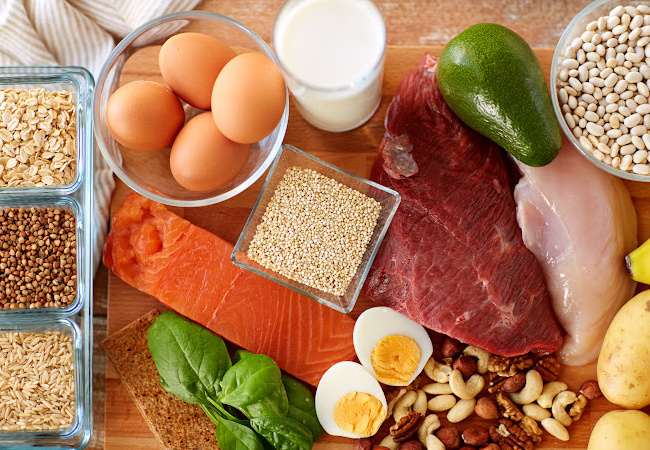
Total Daily Energy Expenditure
This measure, which goes by the acronym "TDEE" is the estimate of how many calories your body burns over a 24 hour period, taking into account the energy it uses while resting along with your level of physical activities and metabolic factors.
This is vital in determining how many calories you need to either lose bodyfat or gain muscle. Typically a caloric surplus is required to gain muscle and a caloric deficit, to lose weight. Caloric deficit and surplus, gauge approximately 10-20% of your TDEE to determine this.
Tracking macros made easy
One thing I would heartily suggest is using the free app Cronometer for calculating TDEE, tracking macros and creating a food and nutrient journal.
This software (browser based and mobile apps) can break down all of your micronutrients as well, such as vitamin and mineral intakes, based on what you are eating. Your data can also be exported too. Very handy to look at your intake over time and correlate that with your progress.
Supplements
Although this is beyond the scope of this article, it is recommended that most of the population would be better off with some basic, sensible supplement regimen. My suggestion would be vitamin D, zinc, magnesium and creatine. Also consider a protein supplement if you do not or cannot consume animal proteins.
Recovery
Training with progressive resistance close to failure causes microtrauma to the soft tissues. This is a stimulus for repair and subsequent growth. This entails: stimulus + proper recovery + supercompensation = hypertrophy.
If any of these are suboptimal, then growth will also be. As you progress in your journey of training, so-called "listening to your body" will become more of an acquired skill with regards to how you are feeling and how many rest days you need and so on.
Cardio
Although cardio is not as effective a means to lose body fat as proper diet is, it is nonetheless required to ensure cardiovascular health. I would suggest adding some brief but intense sessions on off days.
Something like the "Tabata Protocol" can make such short cardio sessions more effective, going all out for 20 seconds and then drastically dropping intensity for 10 seconds. This works very well with skipping rope. For those who want to avoid impact, it is recommended to use an elliptical trainer or rowing machine if you have access to them.
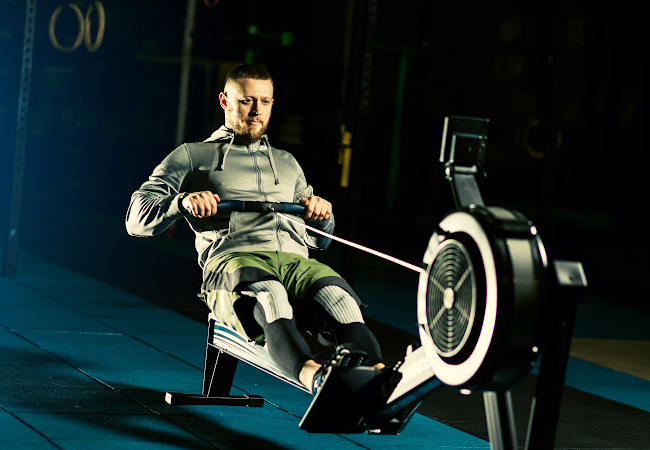
A Starting Point: Building the Base
The question of where and how to start on day one is where things begin to get subjective here. It could be that you are in your mid-30s and have never exercised - your body is not used to it at all. Or you could be at a point where you are set to get back into working out after a very long layoff.
In these sorts of cases I would advocate starting off with a bodyweight callisthenics workout to get acclimatised to strength training, increase your tolerance for exercise, strengthen your tendons, ligaments and supporting soft tissues, work out strength imbalances and improve your overall conditioning and circulation, so that when you do begin working out with weights, it will be a much easier transition.
Simple Beginning Bodyweight Fitness Routine
A very simple approach would be to target the whole body with these exercises below, each done one after the other. When you have done all of these movements, this will be counted as "one circuit".
You can repeat this circuit 3-5 times, 3-5 days a week. The repetitions for each movement will depend on your ability, so I would do as many as you can in good form or until you can do sets of 10-20 repetitions.
I would do this for 3-4 weeks to acclimatise your body to exercise before moving on to one of the routines below. Again, this is only for those who are starting out with no real prior experience with strength training or those who haven't been at it in a very long time.
- Push-ups
- Prisoner Squats
- Step-up on 12"-16" block
- Inverted Row (can do this on a 45 degree angle)
- Glute Bridge
- Hollow Body Hold
- Prone Back Extensions (aka "Supermans")
Routine Progressions: Beginner Strength Training Routines
For those who are new to strength training or those with excess physical activities/poor recovery the simple, brief abbreviated routine that targets the major muscle groups done in two weekly training sessions is the perfect starting point to set some small goals for oneself and develop the habit of working out.
(note: many others can make very good gains on this abbreviated routine as well, and it could be particularly useful for some with extremely limited time, or due to stress from work, personal matters, lack of sleep due to a newborn and so on)
Everyone else can start with the "A-B Beginner Routines", doing one for two to three months and then the next one for the next two to three months, before moving on to one of the two split routines below. This all will likely be enough to plan your first year of training around.
These routines deliberately do not include direct bicep and triceps exercises as they will get enough direct and indirect stimulus from the compound exercises.
Starting Small: Simple Abbreviated Routine
Workout A
Deadlift 5 x 6-8 reps
Dips 5 x fail reps
Workout B
Squats or Machine Squats or Leg Press 5 x 12-15 reps
Palm-Facing-Grip Lat Pull Down 5 x 12-15 reps
note: for those that cannot perform dips, it is advisable to gain enough strength to perform them by first using one of two assisted techniques, either a band-assisted dip or a machine-assisted dip.

A-B Beginner Routines
A-B Beginner Routine #1
Workout A
Squats 4 x 12-15 reps supersetted with:
Cross-Bench Dumbbell Pullovers 4 x 12-15 reps
Dips 4 x fail reps supersetted with:
Chin-ups 4 x fail reps
Workout B
Deadlift 4 x 6-8 reps
Dumbbell Bulgarian Squat 4 x 8-12 reps
Incline Dumbbell Press 4 x 8-12 reps
One-Arm Dumbbell Rows 4 x 8-12 reps
note: The term "superset" implies doing one set of the first exercises and then a set of the second. For example, one set of squats, then one set of pullovers and so on. For those that cannot perform dips or chin-ups, it is advisable to gain enough strength to perform them by first using one of two assisted techniques, either a band-assisted dip/chin or a machine-assisted dip/chin. For deadlifts, one can pick any variety they choose: conventional barbell deadlifts, "sumo" deadlifts, trap bar deadlifts, or even dumbbell deadlift.
A-B Beginner Routine #2
Workout A
Barbell Squat 4 x 8-12 reps
Flat Dumbbell Press or Bench Press 4 x 8-12 reps
Chin-Ups 4 x fail reps
Seated Dumbbell Press 4 x 8-12 reps
Workout B
Deadlift (with a Trap Bar if available) 4 x 6-8 reps
Leg Press 4 x 8-12 reps
Dips 4 x fail reps
Seated Cable Rows or Dumbbell Rows 4 x 8-12 reps
Split Routines
After 4-6 months of training in the above full-body routines you will have gained likely anywhere from 8-15 pounds of lean mass (provided proper nutrition, training and rest) and it will be time for more specialization in terms of adding in some single joint exercises such as direct bicep, tricep, calf, and deltoid raises etc.
Split Routine #1 - Full-Body Push/Pull
The idea here is to combine upper & lower body pushing on one day and upper & lower pulling on another. This will become immediately apparent when doing this routine. The training frequency here can be varied, depending on you. It could be done Monday(pull)-Wednesday(push)-Friday(pull) or one day one, two days off etc.
Push
Incline Dumbbell or Barbell Press 4 x 8-12 reps
Squat or Leg Press 4 x 8-12 reps
Dumbbell lateral raise 3-4 x 8-12 reps
Barbell French Press 3-4 x 8-12 reps
Calf Raise 3-4 x 8-12 reps
Pull
Romanian Deadlift or Rack Deadlift 4 x 6-8 reps
Chins or Pullups 4 x 6-8 reps
Dumbbell Row 4 x 8-12 reps
Barbell or Dumbbell curl 3-4 x 8-12 reps
Leg curl 3-4 x 8-12 reps
Split Routine #2 - Push Pull Legs
This is one of the most enduring ways to train for a reason, it packs on muscle so efficiently because of the "overlap effect" of training complimentary movers on one day.
For example, take the "push day" below: when working incline press, bench press and dips, say you were to do 5 sets of each, you would have actually done 5 sets for each muscle group - chest, shoulders and triceps, in just three exercises! The same with a pull day, where rows, pulldowns and chin-ups all contribute to overall training volume for these same muscles.
Monday (Chest, Shoulder, Triceps)
Incline Dumbbell Press: 4 warmup sets (15, 12, 8, 6) 1 working set (8-10 reps to total failure)
Medium-Grip Bench Press (18"-20" grip): 4 warmup sets (15, 12, 8) 1 working set (8-10 reps to total failure)
Dips: 3 warmup sets (15, 12, 8) 1 working set (8-10 reps to total failure)
Wednesday (Lower Back, Lats, Traps, Biceps)
Deadlifts: 4 warmup sets (15, 12, 8, 6) 1 working set (8-10 reps to total failure)
One-Arm Dumbbell Rows or Dumbbell Pullovers: 4 warmup sets (15, 12, 8, 6) 1 working set (8-10 reps to total failure)
Chin-ups: 3 warmup sets (15, 12, 8) 1 working set (8-10 reps to total failure)
Friday (Quads, Hamstrings, Calves)
Squat or Leg Press: 4 warmup sets (15, 12, 8, 6) 1 working set (8-10 reps to total failure)
Dumbbell Split Squats: 4 warmup sets (15, 12, 8, 6) 1 working set (8-10 reps to total failure)
Calf Raises or Toe Presses: 4 warmup sets (15, 12, 8, 6) 1 working set (8-10 reps to total failure)
Split Routine #3 - Upper/Lower Split Routine
Another very straight-forward way of training is to split your sessions into upper and lower on respective days. This is a very good way to maximize training volume and also manage frequency and recovery.
With this routine we also can prevent some overuse issues and hit the muscles from varied angles by optimally hitting the muscle groups with different exercises on different days through the rotation of the routine.
We can do this routine 2-4 days a week, for example:
Two days a week: week one: Wed (upper #one) - Sat (lower #one) - week two: Wed (upper #two) - Sat (lower #two)
Three days a week: week one: Mon (upper #one) - Wed (lower #one) - Fri (upper #two) - week two: Mon (lower # two)
Four days a week: week one: Mon (upper #one) - Tues (lower #one) - Thurs (upper #two) - Fri (lower #two)
Upper Number One:
Medium-Grip Bench Press 4 x 8-12 reps
Incline Dumbbell Press 4 x 8-12 reps
One-Arm Dumbbell Row 4 x 8-12 reps
Machine Pulldown 4 x 8-12 reps
Barbell Curls 3-4 x 8-12 reps
Lower Number One:
Front Squat 4 x 8-12 reps
Single Leg Press 4 x 8-12 reps
Dumbbell Romanian Deadlift 4 x 8-12 reps
Leg Curls 3-4 x 8-12 reps
Machine Calf Raises 3-4 x 8-12 reps
Upper Number Two:
Low Incline Dumbbell Press 4 x 8-12 reps
Seated Cable Row 4 x 8-12 reps
Dips 4 x fail reps supersetted with:
Chin-Ups 4 x fail reps
Incline Dumbbell Curls 3-4 x 8-12 reps
Lower Number Two:
Squat 3-4 x 8-12 reps
Barbell Rear-Foot Elevated Split Squat (aka "Bulgarian Squat") 3-4 x 8-10 reps
Rack Deadlift (aka "Rack Pull") 4 x 6-8 reps
Leg Extensions 3-4 x 8-12 reps
Machine Toe Press 3-4 x 8-12 reps
In Closing
Hopefully this will give you a rough framework for all the most important aspects of beginning resistance training and I wish you the best of luck. One more time I would like to stress the importance of building the exercise habit and that it will be the slow, steady consistency that will see you progress beyond what you initially thought possible!
References:
https://pubmed.ncbi.nlm.nih.gov/30844920/
https://pubmed.ncbi.nlm.nih.gov/22777332/
https://pubmed.ncbi.nlm.nih.gov/14552938/
https://www.health.harvard.edu/mind-and-mood/weight-training-may-boost-brain-power
https://www.ncbi.nlm.nih.gov/pmc/articles/PMC4090891/
https://www.ncbi.nlm.nih.gov/pmc/articles/PMC6377696/
https://www.ncbi.nlm.nih.gov/pmc/articles/PMC2853497/
https://pubmed.ncbi.nlm.nih.gov/18981046/
https://pubmed.ncbi.nlm.nih.gov/34609100/
https://pubmed.ncbi.nlm.nih.gov/18448177/
https://jps.biomedcentral.com/articles/10.1007/s12576-019-00676-7



